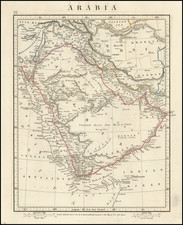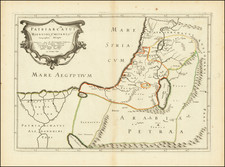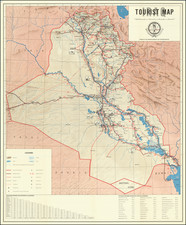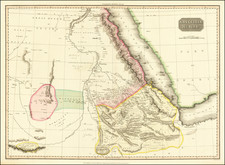Detailed map of the area around the town and port of Mocha in Western Yemen, published by the British Admiralty.
The map includes extensive offshore soundings and coastal features, including the location of the city pier, 3 minarets, 4 mosques and various forts.
A finely executed "Rough Outline Sketch from the Vessel at Anchor in Mokha Roads," based upon an original by Commander Haines in 1836 appears across the top, providing an interesting perspective view of the city and fortifications.
Mocha
Mocha reached its zenith in the 17th century, driven by its importance in the coffee trade, which included about 400 Jewish households. Passing through Mocha in 1752 and 1756, Remedius Prutky found that it boasted a "lodging-house of the Prophet Muhammad, which was like a huge tenement block laid out in many hundred separate cells where accommodation was rented to all strangers without discrimination of race or religion." He also found a number of European ships in the harbor: three French, four English, two Dutch, and one Portuguese
Mocha was very dependent on imported coffee beans from present-day Ethiopia, which was exported by Somali merchants from Berbera across the Gulf of Aden. The Berbera merchants procured most of the coffee from the environs of Harar and shipped them off in their own vessels during the Berbera trading season.
In December 1820, HMS Topaze and ships and troops belonging to the British East India Company attacked the North and South Forts, destroying them. A decade and a half later, Ibrahim Pasha of Egypt would also attack the city and destroy its fortified wall closest to the sea, as well as its citadel. However, by that time, Mocha's trade in its country's precious commodity of coffee grains (Coffea arabica) had already been supplanted by Ethiopia which was the principal trader of this commodity to North Africa and which sold for a third of the price of the same coffee imported from Arabia.
Diplomat Edmund Roberts visited Mocha in the 1830s. He noted that Turkish "rebels" possessed Mocha. The Turks took it over after they left Egypt while being disgruntled with the rule of Muhammad Ali of Egypt. These "rebels", consisting of confederates throughout Arabia, had banded together under one leader named Turkie ben al Mas. Jacob Saphir who visited the city in 1859 wrote about seeing many houses that were vacant of dwellers, although the Turkish governor still dwelt there with a band of soldiers, collecting taxes from local traders and ships visiting the harbor.
When the British took control over Aden, the port in Mocha fell into disuse, being replaced by Aden. The general destruction of the city was still prominent as late as 1909, when German explorer and photographer, Hermann Burchardt, wrote of the city Mocha as he saw it: “This card will reach you from one of the most godforsaken little places in Asia. It exceeds all my expectations, with regard to the destruction. It looks like a city entirely destroyed by earthquakes, etc.”
Rarity
The chart is quite rare. We note only an example at the British Library and a later state of the chart in the National Maritime Museum collection.
The British Admiralty has produced nautical charts since 1795 under the auspices of the United Kingdom Hydrographic Office (HO). Its main task was to provide the Royal Navy with navigational products and service, but since 1821 it has also sold charts to the public.
In 1795, King George III appointed Alexander Dalrymple, a pedantic geographer, to consolidate, catalogue, and improve the Royal Navy’s charts. He produced the first chart as the Hydrographer to the Admiralty in 1802. Dalrymple, known for his sticky personality, served until his death in 1808, when he was succeeded by Captain Thomas Hurd. The HO has been run by naval officers ever since.
Hurd professionalized the office and increased its efficiency. He was succeeded by the Arctic explorer Captain William Parry in 1823. By 1825, the HO was offering over seven hundred charts and views for sale. Under Parry, the HO also began to participate in exploratory expeditions. The first was a joint French-Spanish-British trip to the South Atlantic, a voyage organized in part by the Royal Society of London.
In 1829, Rear-Admiral Sir Francis Beaufort was appointed Hydrographer Royal. Under his management, the HO introduced the wind force scale named for him, as well as began issuing official tide tables (1833). It was under Beaufort that HMS Beagle completed several surveying missions, including its most famous voyage commanded by Captain FitzRoy with Charles Darwin onboard. When Beaufort retired in 1855, the HO had nearly two thousand charts in its catalog.
Later in the nineteenth century, the HO supported the Challenger expedition, which is credited with helping to found the discipline of oceanography. The HO participated in the International Meridian Conference which decided on the Greenwich Meridian as the Prime Meridian. Regulation and standardization of oceanic and navigational measures continued into the twentieth century, with the HO participating at the first International Hydrographic Organization meeting in 1921.
During World War II, the HO chart making facility moved to Taunton, the first purpose-built building it ever inhabited. In 1953, the first purpose-built survey ship went to sea, the HMS Vidal. Today, there is an entire class of survey vessels that make up the Royal Navy’s Hydrographic Squadron. The HO began to computerize their charts in the late 1960s and early 1970s. In 1968, the compilation staff also came to Taunton, and the HO continues to work from there today.












![[Arabian Peninsula] Sexta Asie Tabula [Arabia Felix.]](https://storage.googleapis.com/raremaps/img/small/84313.jpg)
![[The Travels of Paul] Tabula Geographica, in qua omnes regiones, urbes, oppida, et loca describuntur, quorum mentio fit in Actis et Epistolis Apostolotum, et Apocalypsi; de integro multis in locis emendata, ac regionum limitibus distincta, auct. Pet. Planc. . . .](https://storage.googleapis.com/raremaps/img/small/77970.jpg)
